Propane vending machine
Why do I need to insert my bank/credit card in the beginning of purchase?
The card is needed in early phase for security reasons, the machine door cannot be opened until the indentification has been done.
However, your card will be charged only after the purchase has been finalized.
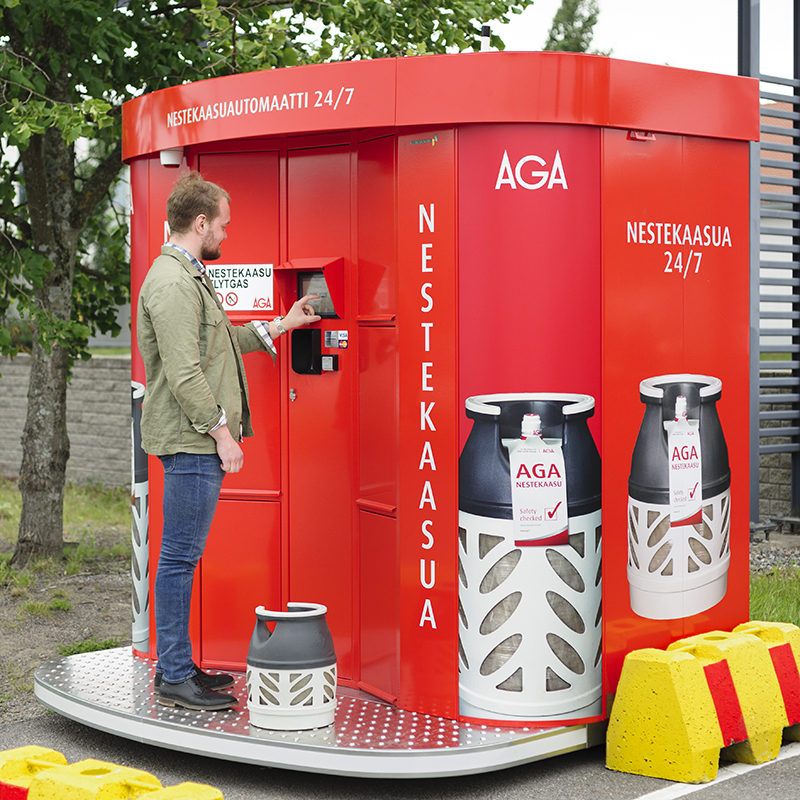
You can return your empty cylinder. 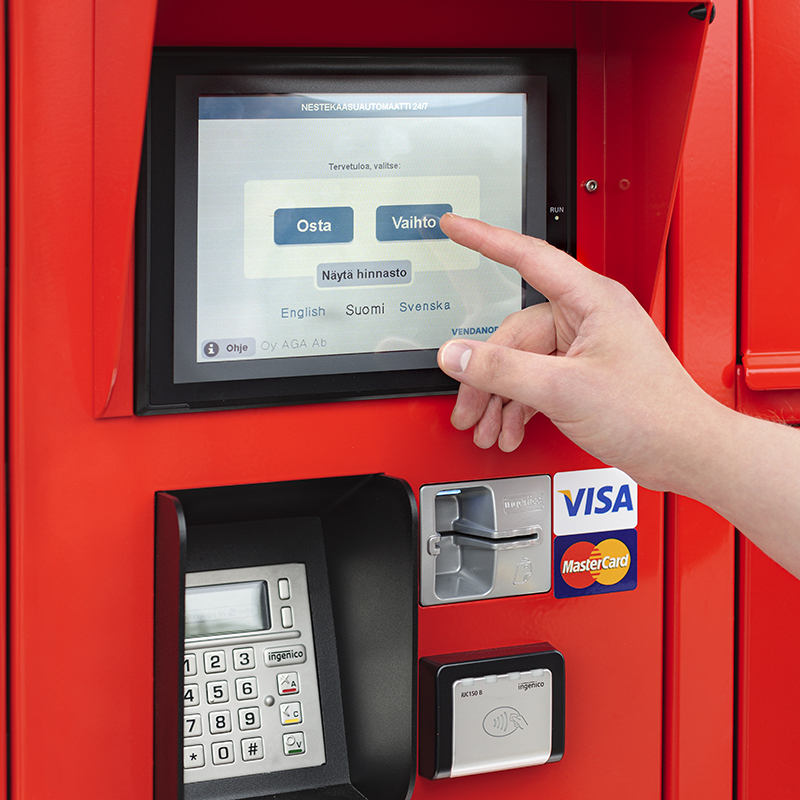
Display guides you further, “Pricelist” tells you which cylinders are exchanged and available. 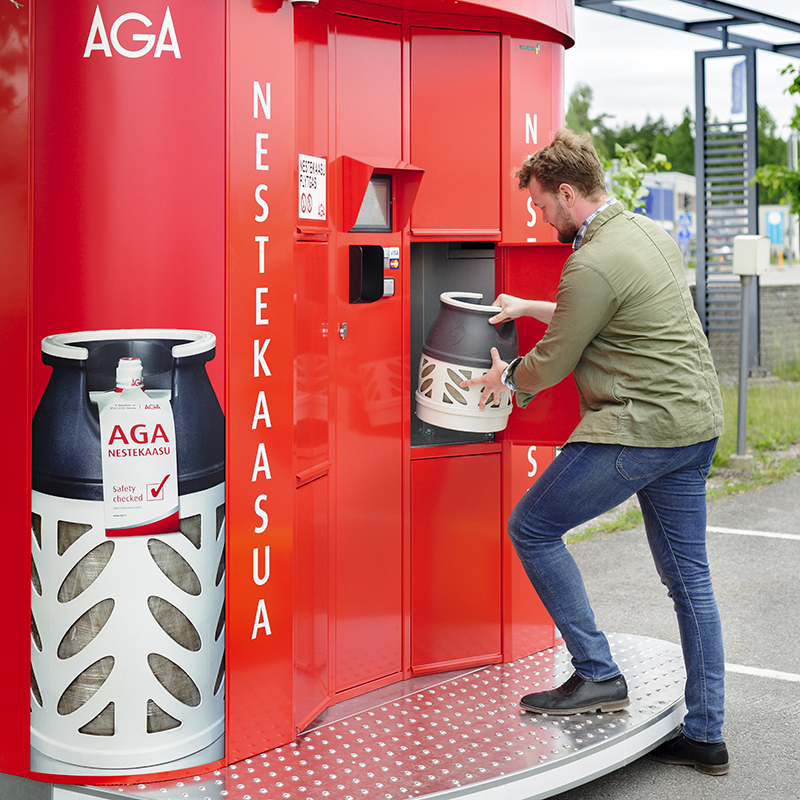
Door opens, put in your empty cylinder. 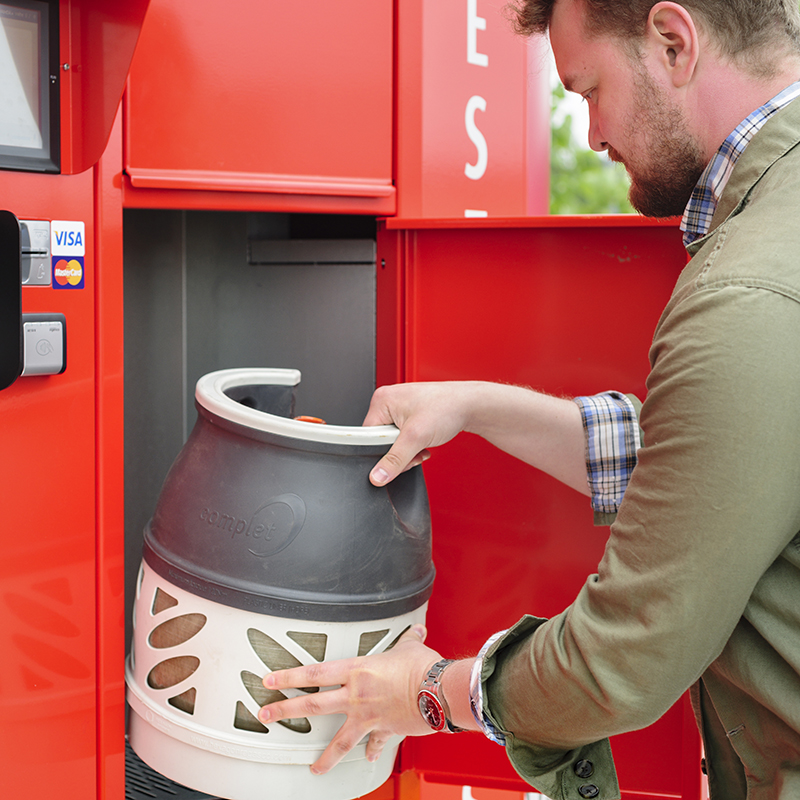
You get full cylinder back.
Machine is out of order.
We monitor our vending machines continuously online. We receive automatic notifications and follow them up with necessary measures. There can be various reasons why the machine is not in operation.
I need a receipt.
Call us or send us an email with your contact information and where you bought propane, what date, as well as the last 5 digits on the card that was used, and we will send a purchase receipt by email.
Where can I buy cylinders that are not sold in vending machines?
You can see all our propane resellers in the “Where to buy” section at my.aga.com
Which cylinders can I buy/exchange?
You can find this information on screen by pressing Price list – Buy or Exchange.

My bank transaction is not approved.
There can be several reasons for this.
Lack of internet connection – we monitor the machines online and take action if the problem persists. If you contact us on the hotline (see the number presented on the machine), it can be clarified.
What type of card do you use? Visa and MasterCard can be used in our machines.
Payment terminal error. Try contactless / blanket on the vending machine. We have from time to time a challenge with the card reader on some machines and they must be cleaned to be able to read the card.
I cannot proceed with buying from the vending machine.
What is shown on the display? Usually the problem is explained.
Is the machine door closed properly? If it is not properly closed, you cannot proceed. The door must be closed properly, preferably with a little force.
What type of cylinder are you trying to exchange? The propane vending machines do not accept all types of propane cylinders. If the cylinder is not approved / recognized, the door will open so that you can take out the cylinder. Press the price list on the display to see all the accepted cylinders.

Display guides you further, “Pricelist” tells you which cylinders are exchanged and available. 
Door opens when you can put in your empty cylinder or get a new full one.
I got the wrong product from a vending machine. What should I do?
We can replace your cylinder but need the documentation on when and where it was purchased. Please contact our customer service by email.
Propane usage
How often should I change the propane hose or regulator?
All propane equipment has a limited lifespan. In order to ensure safe use of propane, remember to check your equipment on a regular basis to avoid gas leakages.
The life of the hose depends on the environment where it is used. If it is affected by sun and temperature changes, it needs to be replaced more often than if it is always under cover, protected from wind and weather changes. Always use approved hoses for propane use – their color is orange. The standard hose must be manufactured and marked with ISO 3821: 2010.
A regulator must ensure stable and correct gas pressure for your gas product and therefore be treated carefully and protected from weather. Store the regulator dry and avoid soil/dirt.
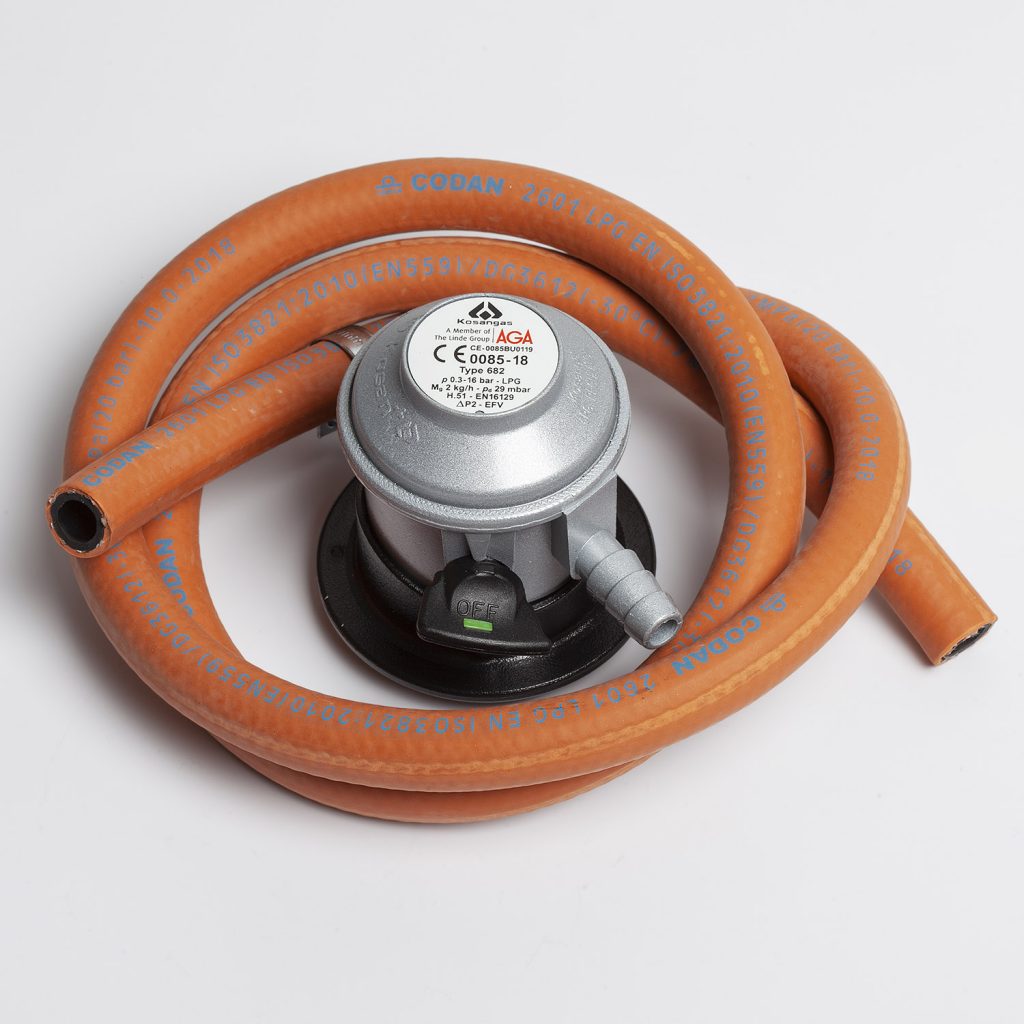
Regulator for click-on valve 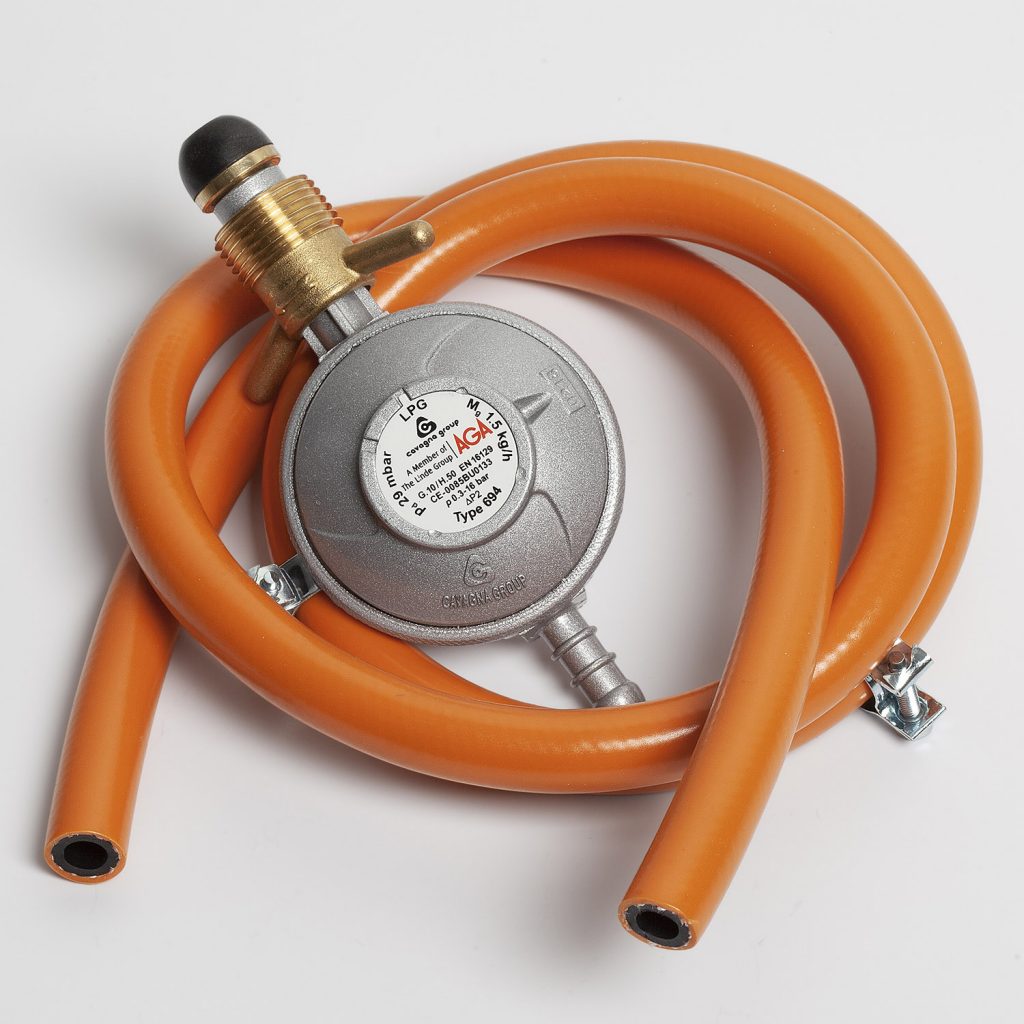
Regulator for screw valve 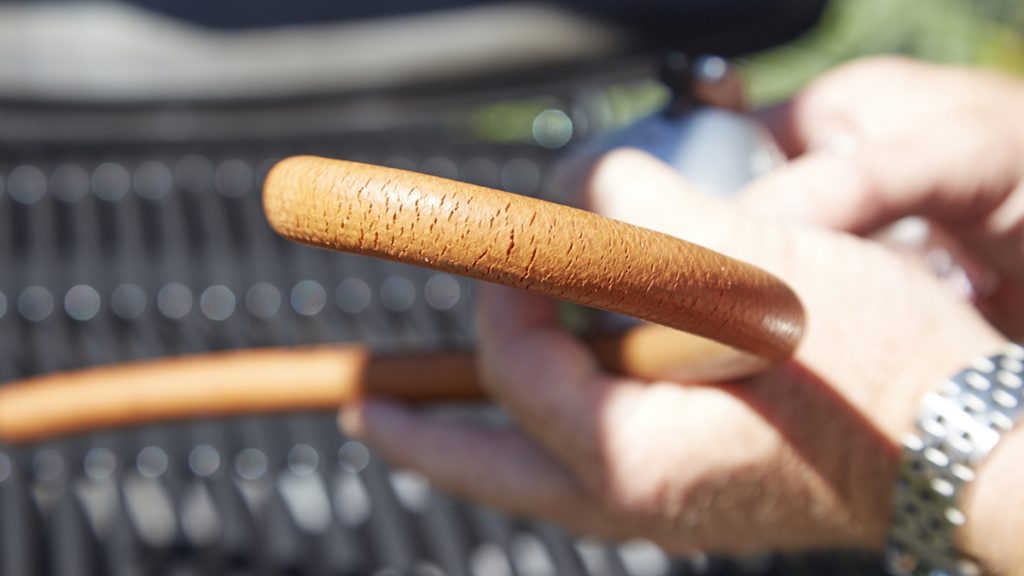
Example of hose NOT to be used – safety risk! 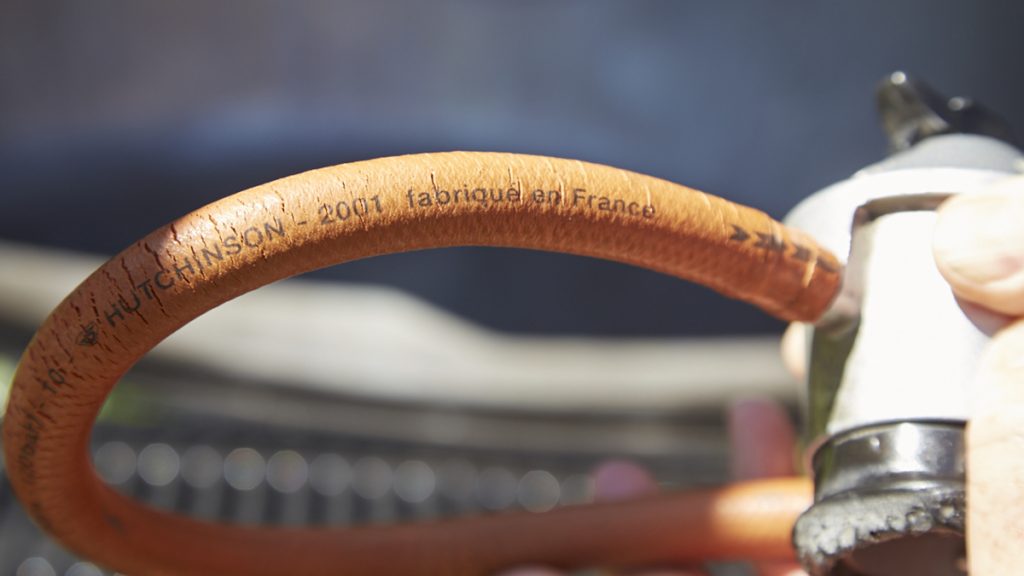
Example of hose NOT to be used – safety risk!
What kind of propane regulator should I use?
There are two types of valves on propane cylinders in the Nordic (except Sweden) and Baltic countries: click-on valve (mostly used by consumers) and screw/pole valve (industrial use). These valves need different kinds of regulators. The regulator reduces bottle pressure and gives the right gas pressure to your gas device.
All gas-consuming appliances that are used indoors in private households must use a low-pressure regulator of 30 mbar. This applies to stoves, heaters, grills and patio heaters etc.
For safety reasons, the regulator has a built-in hose break valve. In the event of a hose breakage, the regulator will shut off the gas supply.
Some gas appliances require higher pressures, as special regulators are used which provide 0.5 – 4 bar. This applies to industrial installations, gas tools, high-pressure burners and construction dryers etc.
Therefore, always check the equipment you are going to use and make sure you have the right kind of regulator.

Regulator for click-on valve 
Regulator for screw valve
Why is good ventilation important when using propane?
When 2 kg of propane is burned, 24 m3 of oxygen is drawn, which is why you need good access to fresh air. Ventilation is therefore important for indoor use of propane.
How do I know if my propane equipment is safe to use?
Check your gas devices and equipment every year. An odorant is added to propane in order for you to be able to detect gas leaks in time.
- Spray the hoses and joints with AGA leak finder or apply soap water to them.
- If a joint is leaking, the soap water will bubble. Close the gas cylinder valve at once.
- You can check the gas hose by bending at a steep angle. If you can see hairline fractures in the bend, replace the hose with a new one.
- If the pressure regulator has been leaking, the cylinder must be aired in an open spot outdoors with no open fire, other heat sources or sewers nearby.
- Maintenance and repair of fixed gas systems may only be performed by certified gas installation shops.
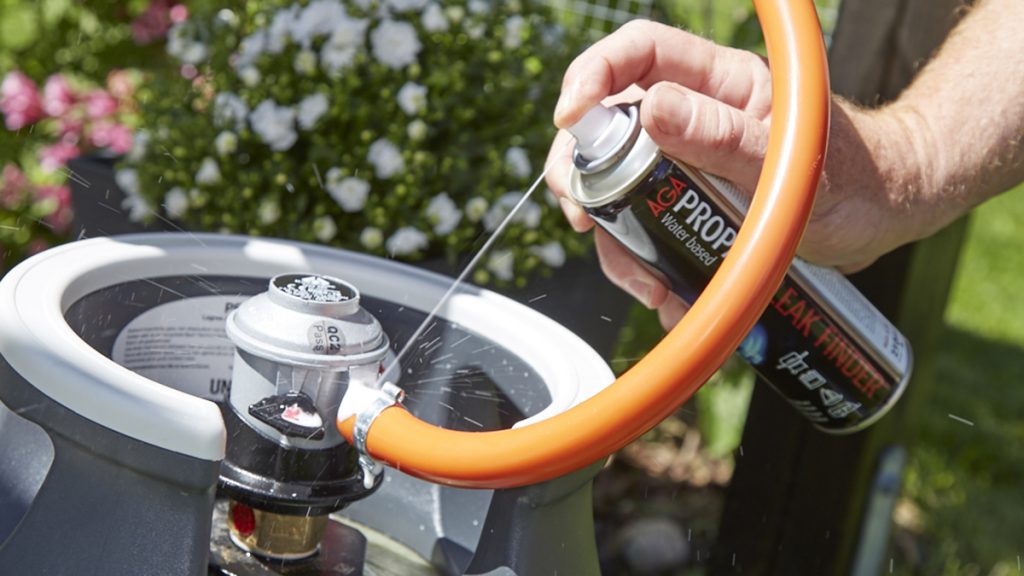
Spray leak finder or soap water to all joints. 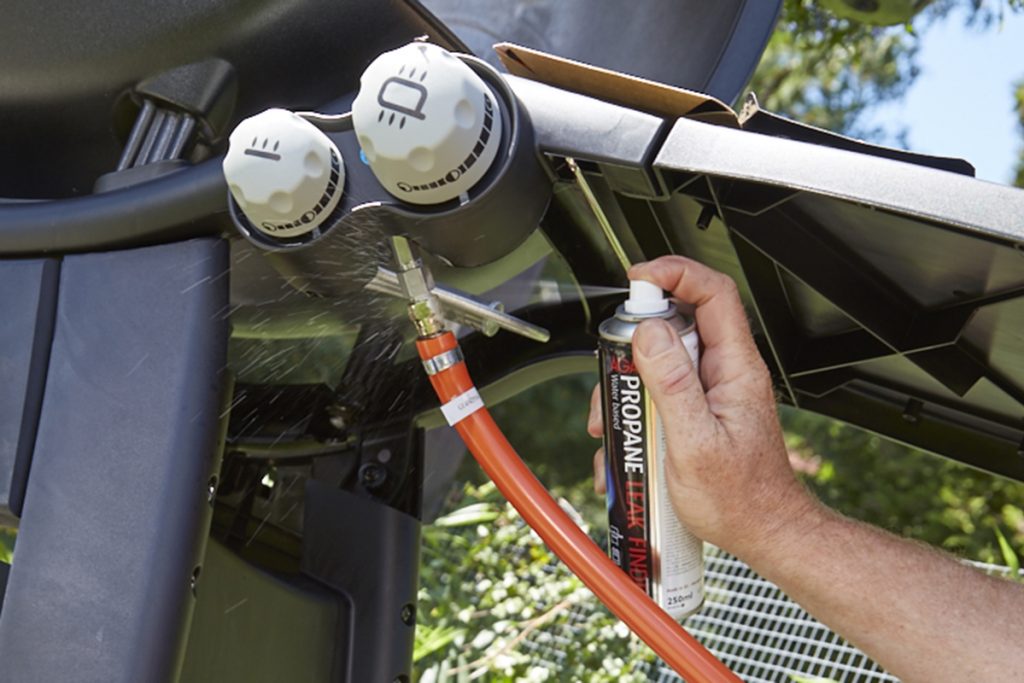
If you see bubbles, there is a leak. 
Hairline fractures => do NOT use 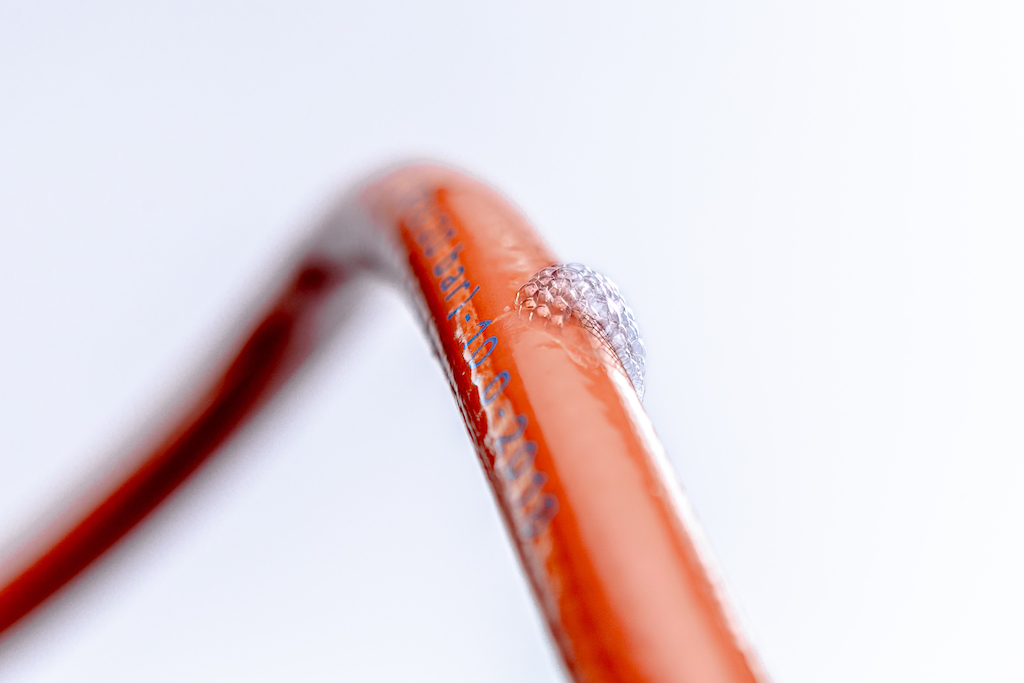
If you see bubbles the hose is leaking => do NOT use
How to handle propane cylinders?
- Ensure that the device has the appropriate type of regulator (check this in the device manual) and the appropriate type of gas cylinder.
- Regularly check the devices and equipment, and ensure they are clean.
- Close the propane cylinder’s valve when not using your gas devices.
- Only certified gas installation shops may perform fixed propane installations. Do not apply your fixes or installations.
- Always use and transport propane cylinders in an upright position. Ensure that the cylinders cannot fall down in mobile installation targets.
- The hoses must be suitable for use with propane and be able to withstand temperatures up to – 30 oC. Propane hoses are orange colored.
How do you attach the pressure regulator into a propane cylinder?
If you have a cylinder with the click-on valve:
- Remove the plastic valve cover.
- Ensure the pressure regulator switch is in the “closed” position.
- Attach the pressure regulator onto the click-on valve cylinder by lifting the fixing collar and by placing the regulator on the cylinder valve.
- Push the fixing collar down until you hear a muted “click” sound.
- You can install the regulator on a screw valve cylinder by twisting the fixing screw counterclockwise.
- Flip the pressure regulator switch to the “open” position, and you are ready to use your gas device.
If you have a cylinder with screw valve:
- Remove the cover plastic from the valve.
- Fit the hose to the pressure regulator.
- Mount the regulator on the LPG bottle. Remember that the connection valve on the LPG bottle is left-handed. You screw the connection counterclockwise. (Does not apply to AGA’s blue camping bottles)
- Open the bottle valve and you can light your grill. It is enough to open the bottle valve one 1/2 turn.
I smell gas, what to do?
Propane is naturally odorless but an odorant has been added for safety reasons, to warn users of possible leaks.
If you smell gas:
- Close the regulator on the gas cylinder at once.
- Remove regulator.
- Do not smoke or use an open fire, and stop using electric devices nearby.
- Ventilate throughly – if you are inside open doors and windows. You may want to move the cylinder outside.
- After ventilation, check the cylinder and joints by using AGA leak finder or soap water.
- Find out the reason behind the gas leakage and take needed corrective actions, e.g. by tightening connections or replacing hose or regulator with a new one.
The test date in my cylinder is exceeded, can I still use it?
You can still use the cylinder but it would be good to change it within one year.
How do you know how much gas is left in a propane cylinder?
You can find out the amount of gas remaining in the cylinder by weighing the cylinder. The cylinder is marked with the cylinder’s own weight, or tare weight, which is subtracted from the total weight. The difference is the amount of gas remaining in the cylinder.
If you have a composite cylinder, it is transparent and you can easily see how much gas is left.
Propane storage
How many propane cylinders I can store at home?
Local laws and regulations define how much gas you can store at home.
Propane is a flammable gas and therefore there are rules for how much gas you can store at home. There is always a risk of fire and therefore it is important that the propane is not stored in the basement or attic. Remember that bottles must be stored upright and secured against shock, fall or excessive heating. Make sure you have adequate ventilation.
How do you store propane cylinders?
- Check from your local authorities what is the maximum amount of propane that may be stored in an apartment, house or garage.
- Since the pressure regulator, valve and equipment are adjusted to accommodate a gaseous state, it is crucial that the cylinder is always kept in an upright position.
- Propane cylinders may not be stored in the attic, basement, underground facilities, washing room or sauna.
- The storage space of propane cylinders must be properly ventilated.
- Propane may not be stored in the same space in which people are sleeping in caravans, boats or similar vehicles.
- On boats, propane cylinders must be placed on the deck in a ventilated cabinet/compartment or, inside the boat, in a compartment separated from the living space equipped with a ventilation shaft leading outdoors.
- Propane cylinders may be stored in, for instance, a kitchen cabinet with ventilation apertures at the top and on the bottom.
- Store your cylinders in a place in which there is no chance of them heating or suffering mechanical damage. The temperature on the cylinder surface may not exceed 40 °C.
- Cylinders must be stored at least 1.0 meters away from stoves, wood-burning stoves and other similar fireplaces. Cylinders must also be located at least 0.2 meters away from surfaces that become warm such as stoves and radiators.
- Cylinders may not be kept under a hot grill; instead, they must be lifted next to the grill.
- When you detach a cylinder from a device for a longer period of time, detach the pressure regulator and reinsert the cap.

Store cylinders well fixed in caravan/motor home/boat in separate, ventilated compartment. 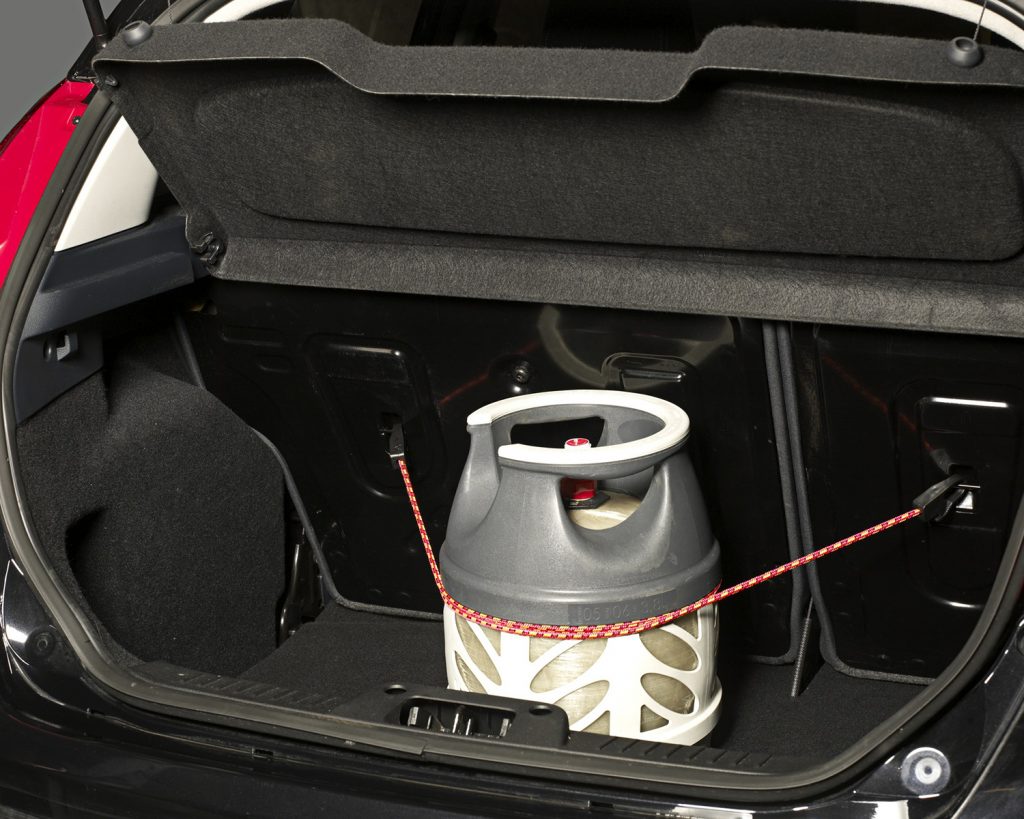
Transport and store cylinder in upright position. 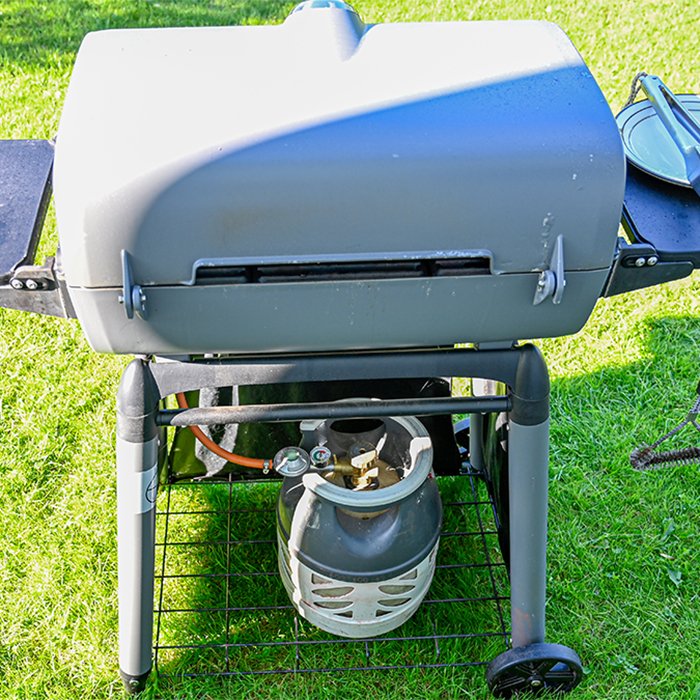
NEVER store cylinder under grill when grilling. 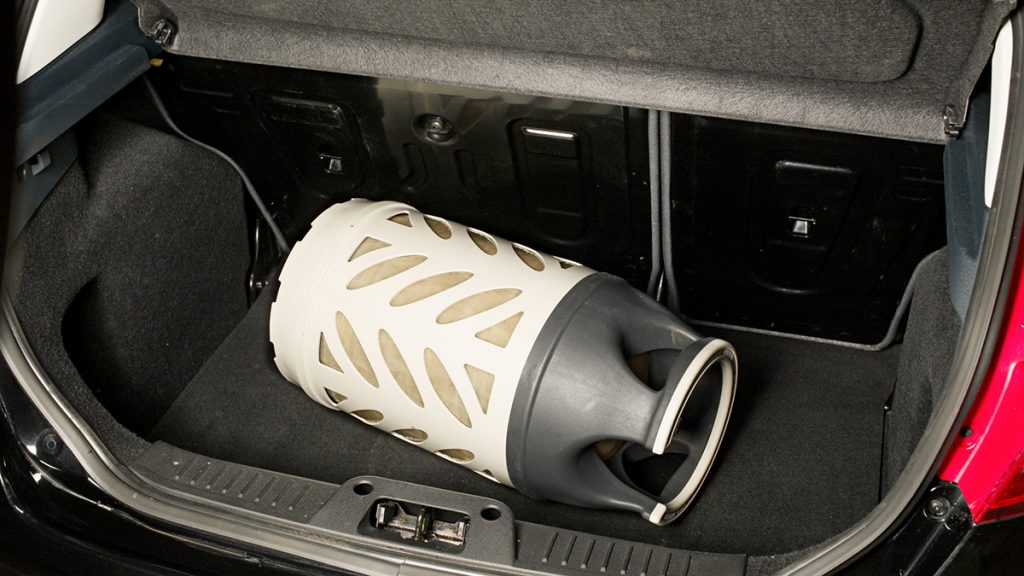
WRONG way of transporting/storing cylinder, cylinder must always be in upright position.
Can I store propane underneath the sink?
Propane cylinders must be primarily stored outdoors, but they can also be stored in well ventilated indoor spaces.
Remember to check the propane equipment regularly to avoid any leakages.
Why must propane cylinders be stored in a vertical position?
The cylinder valve of a propane cylinder has a safety valve that lets out extra gas if the cylinder’s pressure rises too high. The safety valve might not function correctly, if the level of liquid in the cylinder is higher than the cylinder’s safety valve.
Can propane cylinder be stored in a cellar?
No, it is forbidden to store or use propane in closed rooms, especially in cellars. Propane must always be used and stored in well ventilated area.
Propane is approx. 1,6 times heavier than air. Even though it is not toxic gas, it is flammable and at high concentrations it will displace the oxygen in the air and there is a risk of suffocation.
Can propane cylinders be put in outdoor storage during winter?
Yes. Propane freezes at a temperature of -187 oC, meaning that it will never freeze in the cylinder.
Propane facts
How many liters is 1 kg of propane?
1 kg of propane is 1,972 liters of liquid propane.
What happens at a propane filling plant?
AGA propane cylinders are filled at Linde’s modern refilling plants whose operations are steered by extensive safety and quality management systems. All cylinders and valves undergo thorough inspections in connection with refilling.
Since the cylinders are standard products, they are not necessarily refilled by their original supplier. Linde refills its cylinders at its’ local refilling plants in Nordic countries. Complying with applicable regulations, filling plants ensure that the cylinders are safe and in good condition. The cylinders are inspected and maintained regularly in accordance with applicable legislation and standards. This involves, for example, the replacement of valves as well as tightness testing using a hydraulic pressure test. Worn steel cylinders are also sandblasted and repainted. If a cylinder is too worn to be refilled, it is taken out of circulation. Each cylinder is weighed to verify that the amount of gas is correct. The cylinders are also tested for leaks.
AGA propane cylinders refilled by Linde are easily recognized as they are stored in cabinets carrying the AGA logo and warning signs. In Nordic countries, all full AGA propane cylinders have AGA branded plastic cover around the valve.
LPG or propane – what is the difference?
LPG, or liquefied petroleum gas, is the common trade name for propane and butane. LPG is a hydrocarbon manufactured by refining it from crude oil. Propane is a hydrocarbon manufactured from crude oil by means of refinement.
AGA propane, bottled by Linde’s own filling plants in Nordic and Baltic countries, is always high-quality 95 % propane (C3H8). In the cylinder, it exists in a pressurized, liquid form.
The pressure inside a propane cylinder is dependent on ambient temperature, usually ranging from 7 to 9 bar. The filling degree of propane cylinders is 80 per cent of cylinder capacity. A “gas buffer” is left at the top of the cylinder, meaning room for the liquid to expand should the temperature rise.
The properties of propane
- Propane is a flammable, colorless gas.
- Propane is 1.5 times heavier than air.
- Propane is not toxic but has a suffocating effect in large concentrations.
- Propane is naturally odorless, but an odorant has been added for safety reasons – to warn users of possible leaks.
- Propane does not generate soot when burning, as long as sufficient supply of combustion air is ensured (ensure good ventilation!).
- One kilo of propane contains 12.8 kWh of energy. This means a 11-kg propane cylinder will produce over 140 kWh of energy.
If you use propane in cold conditions, remember to check that your cylinder is filled with propane and not butane which has lower evaporation capacity. AGA propane cylinders are always filled with high quality 95 % propane.
How much propane does one 1kW equal?
One kilogram of propane has 12.8 kWh of energy. 1kW is 78.125 g of propane per hour.
Propane transportation
How do you transport cylinders?
- Turn off gas supply and attach the valve cap.
- Keep the valve cap in place throughout transport.
- Always transport cylinders in an upright position.
- Ensure that cylinders stay in one place and are not able to fall over.

Transport cylinder in an upright position. 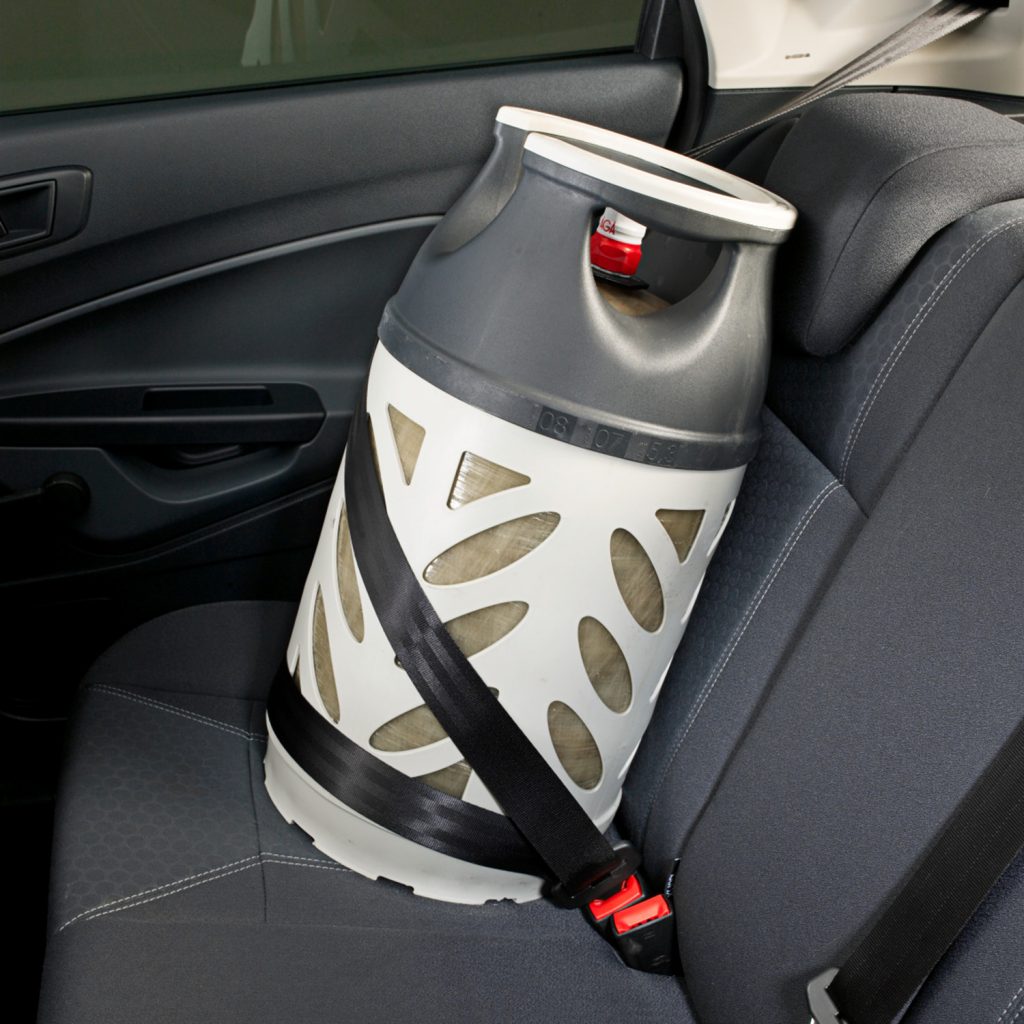
Make sure cylinder stays in place and cannot fall over. 
WRONG way of transporting cylinder 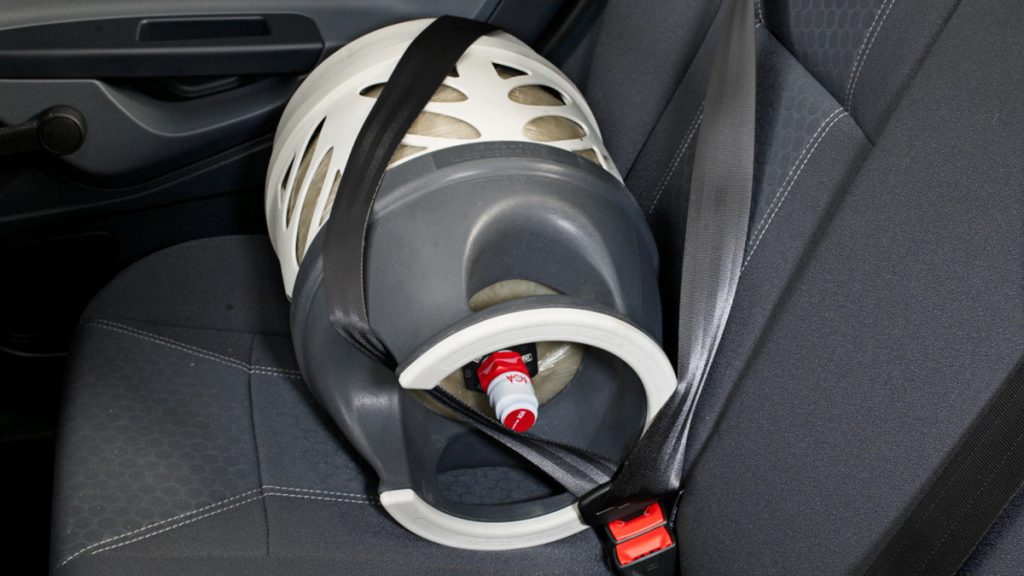
WRONG way of transporting cylinder
Can I transport a propane cylinder in my car?
Yes, you can transport a propane cylinder in a car if it is in a vertical position and well attached, for example with a carrying strap.

Transport cylinder in an upright position. 
Make sure cylinder stays in place and cannot fall over.
Propane pricing
Why is propane more expensive in a composite cylinder than in a steel cylinder?
The acquisition price of a composite cylinder is many times that of a steel or an aluminum cylinder. Additionally, refilling and maintaining a composite cylinder is more expensive. Part of the higher acquisition and maintenance costs are paid in the price of the shell and part in the price of gas.
However, a composite cylinder has many advantages compared to a steel cylinder. Its lightness makes it much more pleasant to handle and its transparency saves the user from many surprises.
How much is the deposit of a propane cylinder?
There is no deposit system for propane cylinders. Check the price of a propane cylinder from your reseller at your propane sales point.
Climate compensated CO2
How can you guarantee that your CO₂ is climate-positive?
We can guarantee our carbon dioxide is climate-positive through the following:
- we comply with the world’s only independent standard on climate neutrality – ISO 14021 – and work alongside an independent, experienced advisor, U&We, in order to perform and report our analysis of the product’s environmental footprint.
- we have commissioned KPMG to carry out an independent study in order to verify our data collection and calculations.
- working with the consultancy Zeromission, we have identified suitable products aimed at offsetting the product’s emissions, and have chosen to invest in Taking Root, a certified tree planting project based in Nicaragua, via PlantVivo. Offsetting 110% of the product’s emissions ensures it is climate-positive.
Why are you focusing on green carbon dioxide?
More and more of us are aware of the problems associated with using disposable plastic, how it pollutes the world’s oceans and has long-term consequences for animal and plant life, among other effects. It is increasingly well-known that using carbonated water at home means buying far fewer disposable plastic bottles, which reduces transportation and saves money.
We wanted to go one step further and steal a march on our competitors by offering the consumer climate-positive carbon dioxide.
Our commitment to the Taking Root project means we offset more than we emit by planting trees. By offsetting 110% of our emissions by planting trees which bind carbon dioxide from the atmosphere while they grow, we contribute to a positive climate impact. This means the product can be classed as climate-positive.
Why did you decide to plant trees in Nicaragua?
There are two main reasons why we chose this project:
- Firstly, it’s important to invest in tree planting projects that would otherwise not have been carried out (this differs from tree planting in certain Nordic nations, for example, where replanting after felling is a statutory requirement).
- Secondly, the trees planted around the equator grow more quickly, and since the greatest absorption of carbon dioxide occurs during the growth phase, this benefits the climate more quickly and effectively.
In addition to the positive impact on the climate, we also saw an opportunity to benefit the local community.
Why did you choose the Taking Root project?
Working alongside the consultancy Zeromission, we have identified suitable projects intended to offset the product’s emissions. We then made the decision to invest in Taking Root, a certified tree planting project based in Nicaragua, via PlantVivo. In addition to compensation, it was important for us to identify a reliable, effective project that creates real value and has a positive climate impact.
The Nicaragua Taking Root project guarantees the trees are planted in a sustainable way, and as well as having a direct impact on the climate, ensures the biological diversity of different species and methods of cultivation. The trees also bind water, which prevents landslides and provides shade for animals as well as vegetation.
As well as helping the environment, the project also benefits the local community. Local farmers are offered regular payments in return for diligently planted and carefully maintained trees. Just over 600 small-scale farmers are currently involved in the project.
What is meant by 110% climate compensation by planting trees?
Trees bind and store carbon dioxide naturally through photosynthesis. This means that what is emitted by our product in the form of carbon dioxide (that is, carbon dioxide equivalents) is absorbed from the atmosphere and bound while the trees planted as part of the Nicaragua Taking Root project grow. Photosynthesis binds carbon dioxide from the atmosphere, which purifies the air.
What does green CO2 mean?
AGA’s green CO2 concept has three main components:
- We identify our total environmental footprint
We have engaged both internal and external experts (U&We) in order to identify all the emissions associated with our product’s life-cycle based on the ISO-14021 international standard, spanning raw materials, production, distribution and consumption as well as emissions linked to related activities such as trips made by sales representatives and handling of packaging materials. This has enabled us to identify the product’s total carbon dioxide footprint (carbon dioxide equivalents). In addition, the process and data collection have been verified by an external, independent third party (KPMG). - We strive to reduce our emissions
Based on our analyses, we have identified a number of areas of improvement in order to reduce our emissions. The process of identifying new, smarter solutions and measures in order to further reduce our environmental footprint has been prioritised and is continually in progress. - We bind at least 110% of our emissions
We offset our emissions by planting trees which bind carbon dioxide from the atmosphere while they grow. In order to further reduce our climate impact in the atmosphere, we have chosen to compensate an additional 10% in excess of our environmental impact. This means the product is climate-positive.
CO2 facts
What happens at a CO2 filling plant?
AGA CO2 cylinders are filled at Linde’s modern refilling plant in Estonia. Cylinders are carefully checked, and maintenance is performed regularly, in accordance with regulations and standards. Safety valves are replaced, the cylinders are leak tested and worn steel bottles are sandblasted and repainted. Bad cylinders are completely taken out of service. Each cylinder is checked to ensure proper gas flow and the valve is provided with a plastic shrink cover.
Where is CO2 used?
Carbon dioxide (CO2) has a very wide range of uses, with many industrial applications. We find carbon dioxide in many different industries, where it meets widely diverse requirements.
Below are some examples.
Carbonation
Carbon dioxide makes soft drinks and water bubble. The gas is infused into the beverage and dissolved in the liquid under high pressure. When the beverage is opened, the pressure is released, and the carbon dioxide is released from the liquid and bubbles form.
Freezing of foodstuffs
Carbon dioxide in liquid or gas form is used in the foodstuffs industry for refrigeration, flash freezing and refrigeration during transport. In its solid form, carbon dioxide is called carbonic-acid snow or dry ice.
Fire extinguishers
The inert properties of carbon dioxide make it ideal for use in fire extinguishers. Carbon dioxide extinguishes the fire by cooling and excluding air.
Medicine
Carbon dioxide is used in arthroscopic surgery, among other things. It can also be added to oxygen to stimulate the patient’s breathing.
What is CO2?
Carbon dioxide (CO2) is of great biological significance and plays an important role in the Earth’s climate.
Carbon dioxide is formed in the body and is released when we breathe. In nature, plants convert carbon dioxide into water and sugars with the aid of photosynthesis. What cannot be stored is converted again, often into cellulose, starch and fat.
In normal conditions, there is an approximate balance between the carbon dioxide that is released through breathing and combustion and that which is bound through photosynthesis. When fossil fuels are burnt, the balance is disturbed and greenhouse gas is formed, which contributes to global warming and the disturbance of the Earth’s ecosystem.
Carbon dioxide is odorless and colorless at normal temperatures. At low temperatures, the gas converts to a solid state, so-called carbonic-acid snow or dry ice. At normal pressure, dry ice sublimates to gas form. Carbon dioxide is easily soluble in water and then forms a water solution that contains the weak acid, carbonic acid, H2CO3. Fermenting agents form carbon dioxide, which forms small gas bubbles in baked goods. As a preservative, carbon dioxide is designated by the E number E 290.
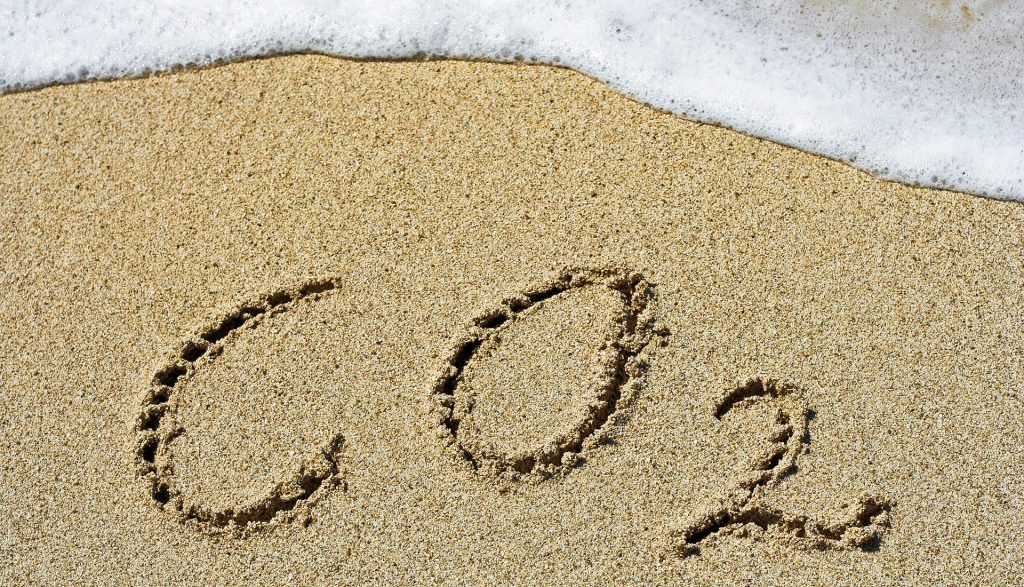
CO2 usage
What to remember when using CO2?
Remember to always handle carbon dioxide cylinders with care and follow the instructions provided on the bottles:
- Handle the bottle with care
- Protect the bottle against abnormal heating
- Store and transport the bottle with the plastic plug attached
Move the bottle to a safe place in the event of fire - Children should not handle CO2 cylinders.
All AGA CO2 cylinders, filled by Linde, are made to meet regulations and requirements for pressurized vessels. On each cylinder there is a safety valve (rupture disc), that breaks in the case of fire, so the carbon dioxide escapes.
Carbon dioxide is not a poisonous gas, but it should be handled with respect since it displaces the oxygen in the air. Low concentrations may cause circulation failure and high concentrations can result in unconsciousness.
Usage
What do I need to remember when carbonating water?
Remember to always handle carbon dioxide cylinders with care and follow the instructions provided on the cylinders:
- Handle the cylinder with care
- Protect the cylinder against abnormal heating
- Store and transport the cylinder with the plastic plug attached
- Move the cylinder to a safe place in the event of fire
- Children should not handle CO2 cylinders.
All AGA CO2 cylinders, filled by Linde, are made to meet regulations and requirements for pressurized vessels. On each cylinder there is a safety valve (rupture disc), that breaks in the case of fire, so the carbon dioxide escapes.
Carbon dioxide is not a poisonous gas, but it should be handled with care, as it displaces the oxygen in the air. Low concentrations may cause circulation failure and high concentrations can result in unconsciousness.
Trouble with carbonating water?
Here are some of the most typical problems our customers might face when using sparkling water maker.
- The amount of gas in the water gradually drops.
Your gas cylinder is empty so you need to replace it, or your gas cylinder is too cold so you need to wait until the cylinder warms up. The gas cylinder must only be used when at room temperature. After transportation and frequent use, the cylinder can become cold and less efficient. Avoid touching the cylinder if it is covered in ice. - The spill tray quickly fills with water.
There is too much water in the bottle, remember not to fill bottles above the maximum volume mark. - The amount of gas in the water is low but gas consumption is high.
The washer on the cylinder holder is either missing or leaking. Change the washer, you can order new ones from our customer service.
How do you clean a sparkling water maker and water bottles?
- To clean your sparkling water maker, wipe it with a damp cloth. A mild cleaning agent may also be used.
- Clean water bottles in warm water with a mild detergent and rinse well. Store empty bottles with their lids off.
- Never wash water bottles in a dishwasher. Water bottles can only withstand a maximum water temperature of 40°C.
- Never use solvents or powerful cleaning agents.
